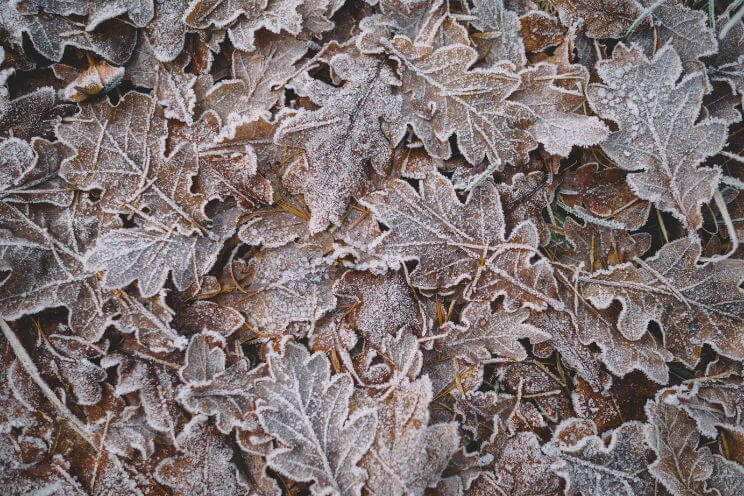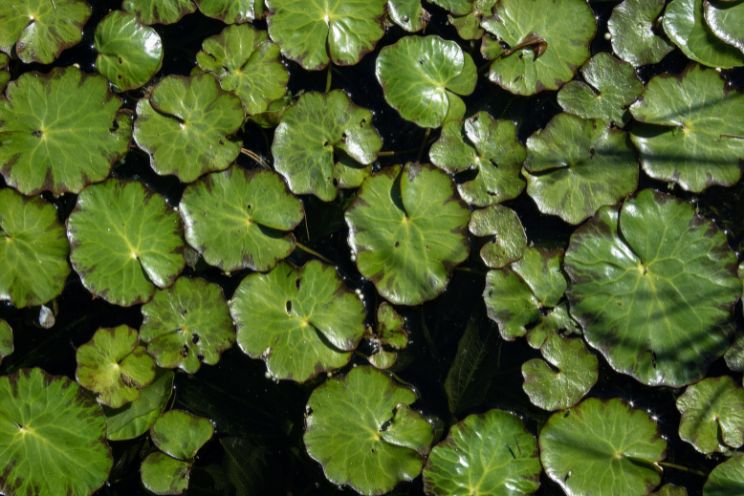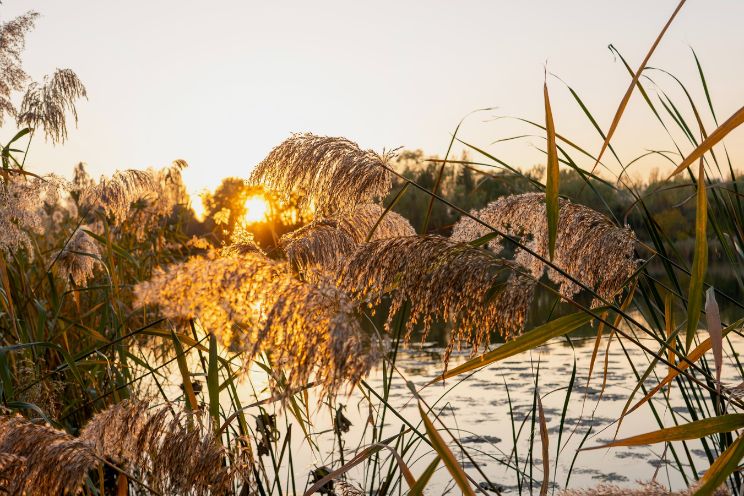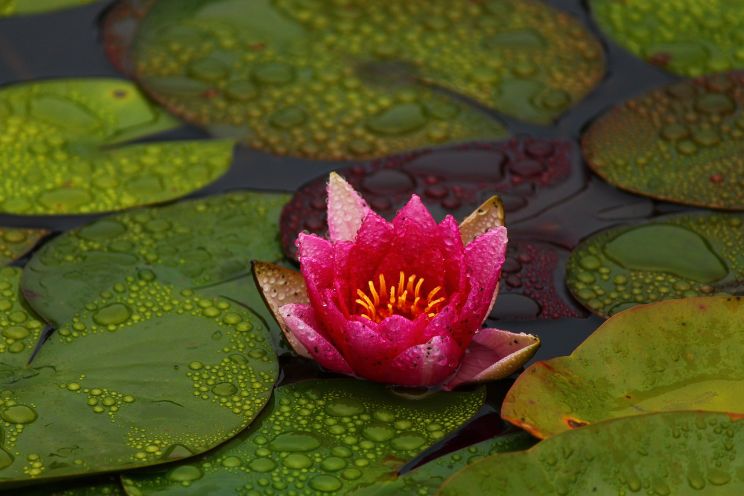You may have a beautifully planted out pond that you made over the summer, and are worried that all your hard work will be gone when winter comes.
But don’t worry, by following our guide on pond plants, we can help by discussing what types of plants can survive over winter untouched and which ones you need to take extra steps to winterise.

Do pond plants die in winter?
There are many varieties of pond plants and while some will survive through winter, others will not.
To make it easier to identify which ones will and which ones won’t, we can categorise pond plants into groups: the perennials, deciduous and annuals.
Perennials, or otherwise called “evergreen”, will survive throughout winter unchanged. Their leaves will remain green all year and while they may slow in growth over winter, they are relatively unaffected by it.
Deciduous plants consist of the majority of aquatic marginal plants – these are things like shrubs, trees and bulbs which have a dieback in the winter, dropping their leaves in the fall and regrowing them in early spring.
Both Deciduous and Perennials have very long lifespans. Most will live for as long as you can keep them, with most trees and shrubs having lifespans in excess of 50 years.
Annuals however, are different in that they have very short lifespans. Most only live for a year or two; they simply grow, flower, produce seeds and then die.
While they are very quick at reproducing and regrowing a new generation the following year, these plants often don’t survive winter and will completely die.

How do you keep aquatic plants alive in the winter?
Most pond plants will survive in winter. The reason for this is because in many countries, it is illegal to keep non-native pond plants as they can be aggressively invasive and damaging to your local ecosystems.
This means that the pond plants you buy at your local garden centre will be well suited to your country’s harsh winters and are fully adapted to survive year round in your pond.
If however, you are concerned that your pond isn’t deep enough or that the plants may completely freeze down to the root, then there are ways to avoid this.
The first is to make sure that the plants are buried deep enough so that the roots don’t completely freeze. Plant the roots 6 inches below the soil or substrate to insulate them from ice.
If this is not possible however, then we recommend potting the plants and containing them in a bucket of water.
This water bucket can then be housed within a shed or cool part of the house where they can be protected from the ice over winter.

Should I cut back pond plants in winter?
Winter is actually the best time of year to prune your plants – this is because during winter, plants have what is called “dieback” which is when the leaves turn brown; sometimes they will fall and decompose and some will stay on the plant.
Either way, the plant enters a state of dormancy during winter, much like how the fish enter torpor, but plants are a lot less active.
During this time, the leaves and dieback can be removed as the plant will not lose much energy and stress is minimised during this winter dormancy state.
Doing this gives you better control over the plant and in spring when it regrows, it will be much more condensed, as opposed to thinly spread shoots popping up all over the place.

What do you do with pond lilies in the winter?
If your pond is 3ft deep and wont freeze completely, then leave them submerged.
Lily Pads will completely die back over winter, leaving only the submerged immature buds and the root system.
From this root system, it remains dormant all winter until spring arrives.
Around March time, the plant will become active again and will send its buds up the the surface where they will open again, and the lily pad will continue to grow the following year.
If you need to take your lily pad out, then keep it potted in a substrate and house it in a cool water bucket. Perhaps keep this bucket in the shed over winter or in the house to prevent it from freezing completely.
When spring arrives, place it back into the pond.

How to keep your pond plants safe until spring
As mentioned, the method of potting and containing your plants within a shed or part of the house over winter is an effective method, although for some, it may be very difficult to remove the plants once they are in.
An alternative method of protecting plants from snow and ice is to place an insulating tarp over them during the night, perhaps a large plastic or rubber mat can be cast over them, and this will protect them from wind and ice.

Hardy pond plants
Most pond plants will grow and thrive in a typical pond ecosystem. As mentioned, they will be native to your area, which means your garden pond is their natural habitat.
Because you are providing a natural space for the plants, they should do relatively well.
However, while it is true that most pond plants are ner enough bomb proof, there are some we always recommend as “starter” pond plants that are very strong and should definitely grow well in your pond setup.
These hardy plants include:
- Barred Horsetail
- Corkscrew
- Orange Peel
- Iris (can grow large)
- Rush
- Fibre Optic Plant
- Scarlet lobelia
- Bull Reed (grows large)
- Variegated Reed (grows large)
- Sweet Grass
- Elodea Densa
- Aponogeton
Marginal plants are by far the easiest of pond plants to keep, often growing like weeds and taking over some ponds as they do so well.
All of these plants will survive through the toughest of winners and can withstand ice and snow very well.

Non-hardy pond plants
As mentioned, most pond plants are fairly hardy as far as plants go. They are amongst the fastest growing and toughest, however, there are some which stand out as being not as easy to keep.
This is mainly due to the fact they require specific environments or can only grow under certain setups. The plants are still fairly hardy and can survive winter, but they aren’t always ideal for every setup.
These tougher-to-keep plants include:
- Lotus
- Water Hyacinth
- Lily Pad
- Water Soldier
- Pitcher Plant

Tips for winterizing your pond plants
The main tips we can give for making sure your plants survive over winter are as follows:
- Plant marginals 6” deep into the substrate
- Fully aquatic plants should be placed deeper than 6” under the waterline and away from the waters edge
- Use tarp or a plastic cover to insulate your pond and plants
- Take exposed plants indoors within a bucket of pond water
- Store hibernating plants in a cool dimly lit area of your home
- Deciduous and perennial plants will come back in spring, annuals will not
- Plants in your area should be native and will likely survive over winter
- Cut back / prune your plants in late winter
How do you store pond plants?
Pond plants should be stored sat in water, as they can quickly dry out.
Marginals, like reeds and rushes, should be stored in pots, as it makes them transportable.
Marginals can survive a period of time with no water, but for the best chances of survival, store them in water dishes or buckets. They may only need a thin level of water in the dish, but as long as the soil stays moist, they will be fine.
Some marginals however, require different levels of soil moisture, and while some can stay relatively dry, others need to be in water at all times. To be safe, always try to keep your marginals in or around some form of water.
Fully aquatic plants should remain fully aquatic, and need to stay completely submerged in water, even when in hibernation, as they can dry out and die in a matter of hours if kept on land.
Try to avoid keeping your plants “warm”, so above room temperature. Your plants may experience meltbacks, where the leaves dissolve and decompose and the roots become soft.
This is why it is best to keep them in the shed or in a cold room, as the sudden move from cold to above 20C / 68F can cause the plant to die.
In conclusion, most pond plants will need little intervention over winter. The ones that do are those that haven’t been planted deep enough into the soil or water, or are in a setup that does not allow for winterisation.
As long as you keep plants that are native to your area, and they are planted within a reasonable depth of your pond, then they should survive over winter just fine.
